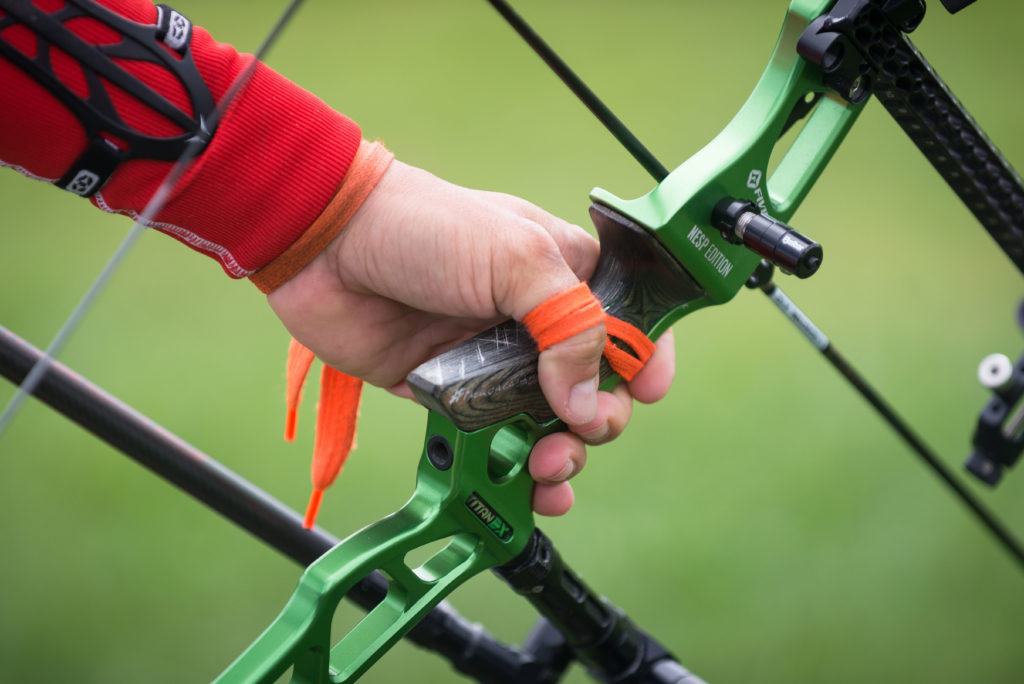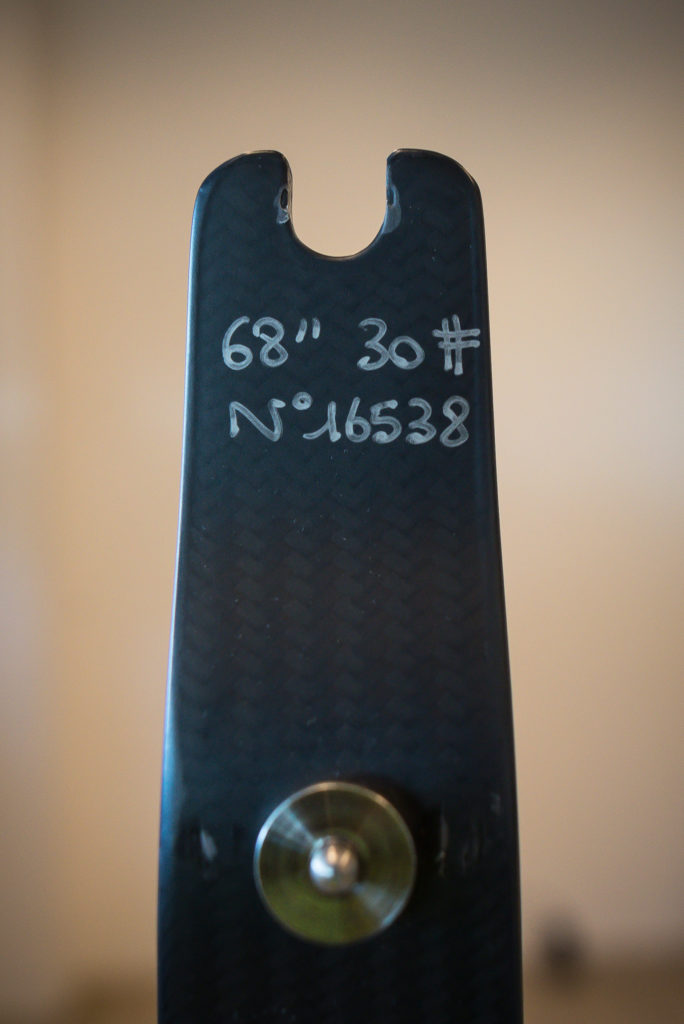One of the most common questions that people unfamiliar with archery ask is along the lines of: “Don’t you have to be really strong to do it?”.
The pretty-much-universal advice is to start shooting at a low bow weight, and work your way up in poundage as your strength and technique improves. For shooting outdoors at 70m, a more powerful bow will push the arrow faster, meaning it will be less affected by stray winds – but being able to control the bow and execute the shot accurately is more important than raw power.
Perhaps a better question is: how heavy does a recurve bow need to be? Indoors, it’s not a problem at all reaching 18 metres with a low poundage beginner’s bow. 30 and 50 metres can be accomplished with 26-28lb.
We asked Andrew Smith of Perris Archery what the average novice would need to reach 70m. “It depends on the limbs.”, he answered. “For example, you can get cheap sub £100 limbs around 36lb, but I have 70 year olds shooting Uukha EX1’s with only 32lb on the fingers. The biggest issue is not just poundage, but getting the hand under the chin – the greater the distance from eye to hand, the better the sight mark.”
There is a general tendency to overbow slightly among many club archers. This feeling is actually quite natural; it suits both the ego and the narrative of progression in the sport – although Chris Wells argued vehemently against this tendency in Bow International 128. With modern limbs, you can get to 70m with a lower poundage than ever before – although reaching 90m or 100 yards effectively still often requires a reasonable jump in weight.
Some of this may be familiar advice to many of you, so we also decided to look at what some of the people at the very top of the outdoor sport were pulling. It’s difficult to generalise, but elite recurve men will usually be shooting a bow that weighs 48-50 pounds on the fingers, occasionally (and colourfully) described as about the same weight as an average bulldog. This means that a qualification round will involve the archer pulling a total weight of well over two tons.
The elite women tend to shoot between 40 and 42 pounds, with plenty of variation outside that range. Great Britain’s veteran Naomi Folkard shot 36 pounds in the nineties, 40-41 pounds in the noughties, dropped her poundage radically in 2009- 2010 after shoulder surgery, and now shoots “between 38 and 40.5 depending on how much training I’m doing, 38 if I’ve had a break and then I’ll build back up.”
At the 2019 Samsun World Cup Final, Bow talked to some of the elite recurve men about their setups. Brady Ellison talked us through his current outdoor rig, based around a Hoyt Epik riser with ILF Hoyt limbs. “I’m shooting 47-48 pounds at the moment. That’s been staying about the same this outdoor season.” he said.
“I used to shoot around 50. I’m shooting an Easton 380 arrow still, but the limbs are now a little faster and they tune at less weight. You want to shoot whatever you can control, and you always want to be in control of the bow. But even if you have control, you need to know your recovery time. You might have control over 53 or 54 pounds, but it will break down your body faster, and after three to four days of training you will get really sore and you’ll need to take two days off.”
“If you shoot a little less you can shoot more consistently. Every day you pick up your bow, and it doesn’t feel heavy.”
Steve Wijler of the Netherlands, unusually, tunes his two Hoyt competition bows slightly differently. “One is 50 pounds, one is 50 and a half. Same arrows though. I’ve built my way up to 50, and I decided that was enough, and I’m not going to increase it any more. I don’t switch to a lower poundage for indoors, either. I want the same feeling all year round.”
A handful of elite indoor archers shoot different setups indoors than out, or will use ‘fat’ arrows in US competitions when permitted, but most elite-of-the-elite recurve shooters now stick with their Easton X10s all year round. Steve’s teammate, archer Sjef van den Berg, said: “I shot 54-55 pounds for the last two years, but I couldn’t quite find an arrow that tuned well but was light enough. So I dropped the poundage to around 50 to shoot a little bit of a lighter arrow and that worked for me.”
“My advice is: don’t go up too much in one go, and listen to your coach about it. If you are shooting too heavy, it’s difficult to get your technique the way it needs to be.”
One of the most successful young archers of 2018 has been Turkey’s Mete Gazoz. Turkish national coach Goktug Erdin said: “Mete is now shooting around 53 pounds, When he started it was about 42. He has a lot of power. I know you look at him and he seems very slim, but he can handle it. This is his personality. We went up in poundage after the Shanghai World Cup this year, and his scores went up, then we changed his arrows too, and his scores really went up, he started shooting in the 680s. We will see what happens next season, but for now we are working with it.”
Even further up the scales, Olympic team gold medallist Mauro Nespoli of Italy is well known for shooting an extraordinarily high poundage. While compound bows in World Archery competitions have an upper weight limit of 60lb, there is no limit for recurves, and at some of the the World Cup events in 2018 Nespoli was shooting a bow at the eye-watering weight of 67 pounds on the fingers. His bow at the World Cup final weighed in just a few pounds less. “But I shot at 62 pounds for the European championships.” he smiled.
“You want to shoot whatever you can control, and you always want to be in control of the bow. Why? The first reason why is the wind. Every competition, there will always be some strong wind. The second reason is that my release is not so good, so a high poundage helps me close up the groups. This is not for everybody, and of course, you cannot start out with this poundage. But I think injuries can be prevented if you work correctly. Other Italian archers shoot at a high poundage, such as David Pascqualucci, but it’s not a national philosophy. It’s just our philosophy.” [laughs].
“To get the arrows to tune, I use 325s X10s from Easton, which are cut at the back. They may be a little soft, but if you shoot well, they stay tight.”
It is not recommended to shoot such heavy bow weights without the supervision of a senior coach. Steve Wijler added: “I see a lot of young people who go up way too fast in terms of poundage, and I would definitely recommend taking it very slow.”
In international recurve archery, the Korean national team remain the biggest fish of all. The ‘great white sharks’ are not generally known for extremely heavy setups, and Chang Hyejin became Olympic champion shooting a bow that weighed just 39 pounds on her fingers (her limbs rate at 42lb, but her draw length is extremely short).
Korean archery concentrates on very high training volumes, and heavy bow weights would be certain to rapidly injure the team out of existence. Coach Kim Seonghoon, the senior hand of the pro team coaches in Samsun, explained: “There is a physical difference between Asian and Western archers. The height and muscle of Asian athletes does not fit so well with heavier bows. So 45-50 pounds is normally the limit for Korean archers. I would not usually recommend more.”
“For younger male archers, 18-19 years old, we are usually looking at getting to around 44 pounds. By the time they get to the senior team, we don’t usually adjust up or down too much. Of course, if they are injured we will change the poundage.”
“Then it’s getting the tune absolutely right. We always try to get the perfect combination between the athlete and the equipment.” The Korean practice is that the coach ultimately takes responsibility for the archer’s bow, and he added: “The coach and the head coach will adjust it individually for each athlete.”
A shorter version of this article previously appeared on the World Archery website.





One more thing to add to this is…
Any increases in poundage must be done at least 3-4 weeks before a major event and only when the current draw weight is correctly controlled. This also applies to adding weights to the stabilisers too.
If you are still working on figuring out your sequence then do not change out your limbs. Technique training means that you must be able to make adjustments without muscle fatigue affecting the new position. You won’t be able to tell if your shot is improving if your body can’t yet handle the added weight.
Bows are not magic wands. There will be no improvements simply because you bought something shiny or because some top archer uses the same model.
Your performance gets better because of adaptive technique, proper planning and mental preparation.
Be kind to your body as it is the only only one you’ve got.
Hi, my name is Cowayne Comarcho age 42 I am a Bahamian Archer from The Bahamas. Archery started in my country in the year 2013, This information was very informative. I would appreciate if you could send me more information in the future. Thanks.
I once bought a second hand Slazenger recurve rated at only about 36 pounds and presumed that it was suitable for a lady. Being a bit macho in my thinking, I decided to make the bow more powerful by adding Polybowtuff on back and belly. Having a certified Salter weighing machine available, I checked the weight and found it to be a full 100 pounds at 30 inches arrow length. Now was my opportunity to see what it might have been like for an English archer to draw a warbow against the French. I could only draw fully and hold for a millisecond before having to release. Now I reduced the poundage by shaving down the sides of the limbs and was reasonably happy at 85 pounds, although that was still too strong for accurate shooting. Then, from around 40 years ago, I sustained injury after injury from motorcycle racing, followed by a car accident, a cycling accident, a boat accident, and then an industrial type accident from over-lifting. Net result was so much damage to my shoulders that I wished for the Slazenger ladies bow again, at only 36 pounds, but I had sold that bow. That was when I started making and breaking my own longbows, strings, arrows, and archery gear to suit my weakened self. Now aged 73, I have just finished my latest English Yew longbow which is 6 feet when strung and weighs 44 pounds, about 4 pounds heavier than the last one made four years ago. Now I am gingerly training myself to easily draw my 29 inch arrows. Wish me luck.